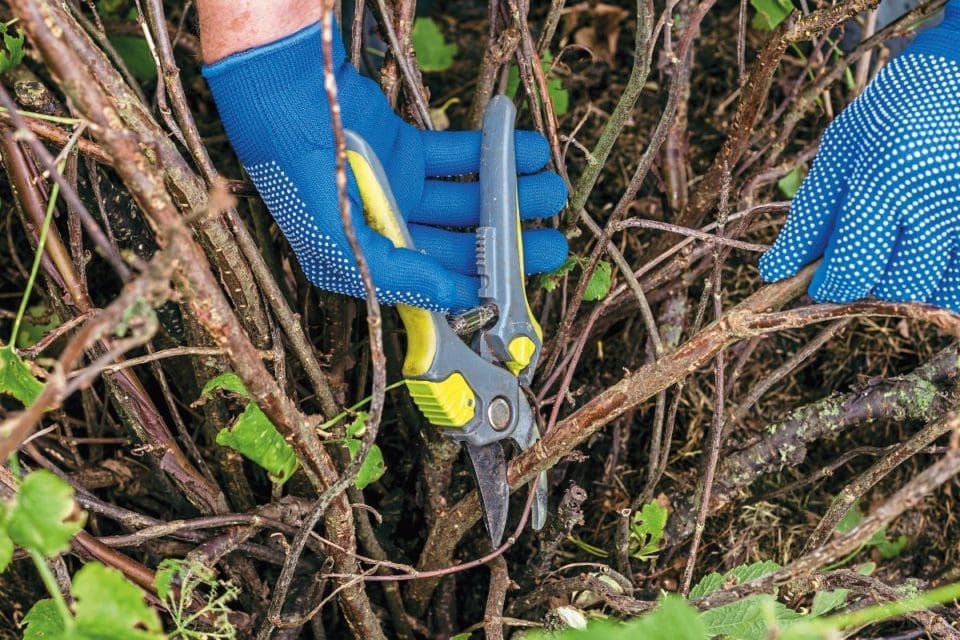Ben Vanheems shares some essential tasks to carry out in your garden and allotment for December.
SOW NOW
Salad leaves and microgreens (indoors)
PLANT NOW
Garlic, rhubarb, soft and tree fruits
HARVEST
Brussels sprouts, cabbage, carrots, cauliflowers, celeriac, celery, endive, Jerusalem artichokes, kale, kohl rabi, leeks, parsnips, swedes, winter radish, winter salad leaves
Make more compost
There’s something wonderful about winter’s pared-back beauty. The rush and clamour of the growing season is behind us, replaced by a more relaxed pace of gardening. There are still jobs to be done of course, but time is on our side.
With growth slowed to a crawl we can turn our attention to the beating heart of the garden – the compost heap or bin. If you haven’t done so already, dig out any mature compost at the bottom of the pile and spread this on to growing areas. It’s fine if it is still a little lumpy at this stage, as it has months to continue breaking down before planting commences again in spring.
The still-to-compost ingredients can then be restacked. As you do this you will introduce valuable air to the pile, feeding the bacteria responsible for decomposition and speeding the process along. And with ready-to-spread compost cleared, there should also be plenty of room for the next tranche of garden waste.
Divide rhubarb
Reinvigorate tired rhubarb by dividing clumps while dormant. Dig up the entire crown then use a spade to break off outer sections containing a bud. Replant into enriched soil.
Support sprouts
Wind gusts can topple lanky Brussels sprouts. Earth up soil at the base of the stems then tie them to sturdy canes for support. Pick sprouts as they mature from the bottom up.
Mulch asparagus
Cut back old asparagus stems to the ground then remove any weeds. Give plants a boost for next season by mulching around them with garden compost.
Harvest artichokes
Continue harvesting Jerusalem artichokes as needed. If you don’t want them to grow back next spring, take care to meticulously harvest every last tuber.
Plant new fruit
STEP 1: With fruit now dormant for winter, there’s no better time to plant new trees, bushes and canes. Bare-root specimens are a lot cheaper and will have plenty of time to settle in before spring. Dig out a planting hole big enough to allow the roots to spread out.
STEP 2: Hold the fruit tree or bush in one hand then backfill the dug-out soil with the other, shaking the tree as you fill to ensure there are no pockets of air. With the hole refilled, firm it in thoroughly from the top, treading it down to give good contact between roots and soil.
STEP 3: Finish off with a mulch. In very sheltered positions you may get away without staking trees. In more exposed locations, hammer in a stake before you set the tree into the planting hole. Once planted, secure the tree to the stake with an adjustable or rubber tie.
Tend to fruit

Seize the lull in gardening jobs to get ahead for next season. Weed around established fruit trees, bushes and canes then follow up with a mulch of compost or well-rotted manure. Lay this about 3-5cm (1-2in) deep, taking care not to bank it up against the main stem, which may cause it to rot.
Check all wires, ties and stakes. Hammer home loose stakes until rigid once more and replace damaged ties or wires. Loosen ties that have become tight, so they don’t dig into the bark.
Begin winter pruning fruit bushes such as blueberries, gooseberries and currants. Prune out dead and diseased wood, as well as branches that are crossing or congested. Up to a third of older blackcurrant branches may be removed to encourage vigorous new growth next season.
Pests & Problems
■ GRUBS: Many pests overwinter in the soil as grubs, ready to re-emerge as soon as things warm up again. Help insect-eating birds help you by raking over the soil to expose the grubs at this lean time of year. Do this several times over the course of the winter.
■ PARSNIP CANKER: Brown or orange patches starting at the shoulder of parsnip roots are signs of this fungus. Use up infected roots promptly. Canker is more likely on poorly draining or acidic soils, so lime your soil if it has a pH lower than 6.5 and add plenty of organic matter to improve structure. Consider canker-resistant varieties such as ‘Avonresistor’.
■ WIND: Strong wind can cause havoc in the garden. Make sure crop covers are properly secured at the edges to stop them blowing away. Tie lofty vegetables like sprouting broccoli to sturdy supports and tidy up and put away anything that might take off in a storm!
Under cover
Clean tools and pots
Tidy house, tidy mind, as the saying goes. Finish tidying the greenhouse (and shed!) this month so you’re ready to commence sowing from a clean and tidy starting point. Sweep surfaces, using a stiff brush to get into all the nooks and crannies. If it’s grimy, use a little washing up liquid to lift off the mud and muck and get things sparkling.
Scrub and wash pots, modules and seed trays. Washing up liquid will help here too. Finish off by rinsing pots in a dilute bleach solution if diseases have been an issue. Allow everything to drip dry then stack neatly.
Gather and wipe clean bamboo canes and other supports then group together in height order so it will be easier to find what you are after next season. Wipe clean tools, using a wire brush or pan scourer to get off anything stubborn, then sharpen edges with a sharpening stone. Finish with a coating of oil.
Force chicory
Forced chicory is a gourmet delight and a welcome addition to the usual winter staples. The ‘chicons’ are produced when plants are grown in the dark, giving delightfully crisp, pale leaves.
Lift mature plants after the first frost then trim the tapering root so it fits into a container. Cut back the leaves to within an inch of the top of the root. Pack three to five roots into a 25cm (10in) container of soil or compost, water, then cover with an upturned pot of the same size. Cover any drainage holes to exclude all light and grow on somewhere warm.
The chicons should take about a month to appear.
Lift and store roots
STEP 1: Consider lifting root crops such as carrots. Most will happily stay in the ground for most of the winter, but this does leave them vulnerable to slugs. Soil may also freeze solid at some point. Prepare dug-up roots for storing by first twisting off the foliage.
STEP 2: Pack roots into crates or breathable boxes of sand or old compost. This should be slightly damp so the roots don’t shrivel, though not overly wet or the roots may rot. Layer the roots in between sand/compost, taking care that they do not touch.
STEP 3: Maincrop potatoes store well in paper sacks or net bags. Store them in a cool, dark place, such as an outbuilding or garage. Lift them off the ground to prevent rodents reaching them. Check stored produce regularly and remove anything soft or rotten.
Make a tool rack

Store your tools in style with a breeze-to-make tool rack like this one. It’s made from an old pallet, some hooks and wood screws for hanging your hand tools and finished with a lick of paint or wood stain to jazz it up. Simply hammer off the top two horizontal boards so it is easier to access taller tools such as rakes, hoes and digging tools, which will sit inside the pallet. Paint the entire pallet then screw in the hooks and screws. Use bronze-effect screws and vintage coat hooks for a touch of class.
Key Jobs for December
■ PRUNE GRAPEVINES
Left unchecked, a grapevine can soon grow to block out much of the light entering a greenhouse. Train branches to form a permanent framework, stopping the growth once the desired length has been reached. Cut back side shoots to a couple of buds on mature frameworks.
■ PINCH OUT SWEET PEAS
Sweet peas make a stunning addition to the vegetable plot, bringing untold cheer, plenty of bees and free posies for the house. If you sowed some in the autumn, pinch out the tips just above a leaf joint. This will encourage side shoots to develop, giving sturdier, bushier plants.
■ CHECK TEMPERATURES
Is your heater up to the job? Check it has kept temperatures up to the necessary level by checking the readings on a max-min thermometer. Keep paraffin heaters topped up with fuel. Some electric heaters include a thermostat, so they turn on only when needed.
■ WATCH FOR SPIDER MITE
Red spider mites can be a nuisance, even in winter. Mild spells may also invite other pests to reappear. Check plants regularly for any signs of pests and act quickly using eco-friendly organic sprays. Needless to say, a thorough greenhouse clean should help avoid this scenario!











